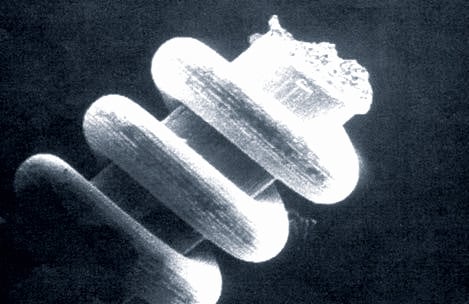
Ural Mountains (Russia) When a team of archaeologists conducted a “geological survey of gold mining” in the Russian Urals, they were shocked to discover numerous strange and mysterious microscopic objects near the banks of the Kozhim, Narada and Balbanyu Rivers. The strange nano-pieces like metal coils, spirals and similar objects are part of a list of unidentified components discovered during geological missions in the Urals. The strange part is that these pieces were embedded in 100,000 year old rock, so they can’t be part of modern machinery. The age of these mysterious nanostructures put them on the list of “Out of Place Artifacts (OOPArt)” given that researchers estimate them to be 300,000 years old. The miniature metal parts were found at a depth of 3 to 12 meters.
An OOPArt (Out of Place Artifact) is a unique and poorly understood object that can be found in historical, archaeological, or paleontological records that fall into the anomalous category. These objects were found when and where they shouldn’t be, thus challenging the conventional understanding of history.
 Although researchers have always drawn a simple and rational conclusion about these strange artifacts, many believe OOPArts may even reveal that humanity had a different level of civilization or sophistication than that described and understood by officials and scientists. Some even think that extraterrestrial intelligent beings are the reason for the existence of OOPArts. To date, researchers have found dozens of OOPArts that include the Antikythera Mechanism, the Maine Penny, the Shroud of Turin, the Baghdad Battery, the Saqqara Bird, the Ica Stone, the Stone Balls of Costa Rica, the London Hammer and many more.
Although researchers have always drawn a simple and rational conclusion about these strange artifacts, many believe OOPArts may even reveal that humanity had a different level of civilization or sophistication than that described and understood by officials and scientists. Some even think that extraterrestrial intelligent beings are the reason for the existence of OOPArts. To date, researchers have found dozens of OOPArts that include the Antikythera Mechanism, the Maine Penny, the Shroud of Turin, the Baghdad Battery, the Saqqara Bird, the Ica Stone, the Stone Balls of Costa Rica, the London Hammer and many more.
The Russian Academy of Sciences in Syktyvkar had run several tests on these mysterious nano-objects and the results were quite interesting as they found that the largest pieces were made from pure copper. The smaller ones are made of tungsten and molybdenum, the same metals that have been used in spacecraft and rockets due to their ability to withstand high temperatures. The smallest length is only 1 / 10,000th of an inch. Scientists involved in the study agreed that there was no technology to make these items 300,000 years ago.
Later these strange materials were subjected to extensive research at institutions in Helsinki, St. Petersburg and Moscow to learn more about their origins and compositions. Now it is clear to the scientists that the metals did not arise naturally in nature, which means that they are components that have an artificial technological origin, in other words, they were manufactured. Initially, there was speculation that the macro- and nano-sized structures were parts that had fallen from missiles from a launch site in Plesetsk. However, a 1996 report ruled out that possibility, saying that these structures were found at too great depth.
Since the time of the World War, the Urals have frequently triggered a number of mysterious events, the most famous of which is the Dyatlov Pass incident, where a group of trained Russian hikers were found dead under very mysterious circumstances. Since then, there have been many conspiracy theories, but to date the incident still remains a mystery. The area is also associated with numerous UFO sightings.
For some, these artifacts are proof that the human race experienced a technologically highly developed period in the Pleistocene (Ice Age), for others they are the work of aliens. Further research must have come to a standstill with the death of Johannes Fiebag, a leading expert in this field, so the mystery of the origin of these strange objects has not yet been solved.






